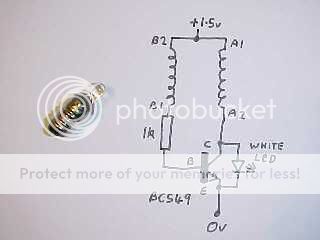First the problem..
So i am building a joule thief.
I am building the ultra simple one that only has the two inductors "coils" 1k resistor and the npn22222 transistor
the problem i have is that when i wire it up to the battery it will flash the LED when it is first connected but that's it then no light if i life the wire and put it back over and over it blinks every time?
I built it to spec and have tried a hand wound coil and i also tried using some 470uh inductors in case there was a problem with my windings...no luck
it does light so i have to assume its working for a microsecond but then nothing..
any ideas?
also is it possible to build a joule thief type circuit that would be capable of putting out say higher amperage then the standard one.. say 200-350ish?
can these little circuits be run in parallel or do they not work that way?
i thought maybe if i put a diode on the output from each circuit to the led to limit any reverse flow and the effect it might have on them..
the tried and true basic original joule thief is a really simple circuit

as can be seen on this site... http://www.bigclive.com/joule.htm
thanks for the idea though!
So i am building a joule thief.
I am building the ultra simple one that only has the two inductors "coils" 1k resistor and the npn22222 transistor
the problem i have is that when i wire it up to the battery it will flash the LED when it is first connected but that's it then no light if i life the wire and put it back over and over it blinks every time?
I built it to spec and have tried a hand wound coil and i also tried using some 470uh inductors in case there was a problem with my windings...no luck
it does light so i have to assume its working for a microsecond but then nothing..
any ideas?
also is it possible to build a joule thief type circuit that would be capable of putting out say higher amperage then the standard one.. say 200-350ish?
can these little circuits be run in parallel or do they not work that way?
i thought maybe if i put a diode on the output from each circuit to the led to limit any reverse flow and the effect it might have on them..
the tried and true basic original joule thief is a really simple circuit

as can be seen on this site... http://www.bigclive.com/joule.htm
thanks for the idea though!


